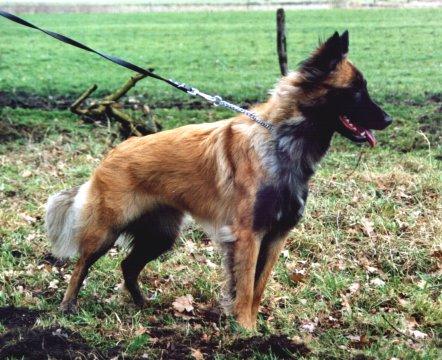Extension masking
The genetics of masking in dogs aren’t completely understood at this time. Some geneticists believe the genetics for masking reside on the E or Extension locus.
The Extension Locus – E
The E refers to the extension of eumelanin (black) over the dog’s body. The dominant form, E, is considered normal extension. The recessive form, e, is called non-extension. A dog homozygous for non-extension (ee) will have its colored dictated by phaeomelanin only…the so-called "recessive red." This distinguishes such a dog from a red or fawn dog that falls into the sable color series on the Agouti locus (Ay) like Belgians do.
Some geneticists have proposed another gene on the E series, Em that dictates black masking, dominant over E. This gene allows phaeomelanin (tan) to be covered with eumelanin (black) over parts of the dog. Which parts are covered seems to be affected by modifiers. At the low end of the scale, the mask might only be black fringing the mouth. At the other extreme most of the head may be black, with considerable blackening of chest and legs. This masking does not seem to be linked to sabling—the sooty overlay to fawn or yellow seen in the Agouti series. Clear fawn dogs may have extreme masking or minimal masking, very sabled dogs may have minimal masking or extreme masking.
Some examples

Here’s a picture of a Tervuren bitch with clear, warm fawn coloring and extreme masking. Notice the sootiness inside her legs, the very dark chest, and high mask.
Here’s a closeup view of a Malinois chest, this time a red colored dog with extreme masking. Note that the black isn’t solid…it’s over red/fawn. The impression is vaguely butterflyish (or batlike, depending on your perception) something I’ve come to associate with extreme masking.
There’s no question that the more coat, and the deeper the base color, the stronger the overall impression of darkness can be…even though a lighter dog shows the black more clearly.
Color fault?
There’s some discussion of whether extreme masking is a color fault in Belgians. Certainly if it occurs without significant charcoaling over the torso, it is more tolerated in the Belgian Tervuren. According to the American Belgian Tervuren club’s Judge’s Education subsite, this falls within acceptable blackening (see http://www.abtc.org/judges_ed/BreedType6.htm plate #101). The standard is fairly verbose but not entirely clear. It states the the chest is typically black. It also states that blackening in patches is undesirable. The Malinois standard is far less explicit, stating only that black tips give an overlay appearance.
